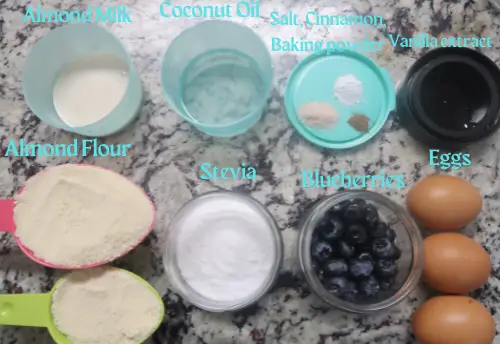Delicious and Healthy Low Carb | Keto Blueberry Muffins Recipe
By: Toya .L
Indulge in the perfect fusion of health and flavor with our Low Carb Keto friendly Blueberry Muffins recipe. These delightful muffins redefine the traditional treat, offering a guilt-free experience that aligns seamlessly with your ketogenic lifestyle.
Crafted with care, our muffins are a symphony of almond flour, rich in wholesome fats and protein, and a burst of plump blueberries that infuse each bite with natural sweetness. Say goodbye to excessive carbs without compromising on taste or texture.
With the gentle aroma of vanilla and the subtly nutty profile of almond flour, every muffin embodies the essence of comfort without derailing your low carb journey. Imagine sinking your teeth into a muffin that’s tender, moist, and utterly satisfying.
This post may contain affiliate links and I may earn a small commission, at no extra cost to you. Please read our *Disclosure policy here.

Can I really enjoy blueberry muffins on a low carb or keto diet?
- Yes! Our Low carb keto blueberry muffins are specially designed to fit within the carb limits of a ketogenic or low carb diet. We use almond flour and stevia to reduce carbohydrates while still delivering a delicious flavor.
How many carbs are in a typical serving of low carb keto blueberry muffins?
- There are only 7 net carbs in our Low Carb Keto Blueberry muffins recipe.
❤️What’s to love about this Low Carb Keto Blueberry Recipe❤️
❤️Carb Control: Traditional blueberry muffins are often loaded with carbohydrates from refined flour and sugars. Low carb Keto blueberry muffins, on the other hand, are crafted with low-carb flours like almond or coconut flour, and sweetened with alternatives like erythritol or stevia, helping to keep your carbohydrate intake in check.
❤️Blood Sugar Management: The reduced carb content in our Low carb Keto Muffins helps prevent rapid spikes in blood sugar levels. This is particularly important for individuals with diabetes or those aiming to maintain steady energy levels throughout the day.
❤️Ketosis Support: Staying within your daily carb limit is crucial for maintaining ketosis, a metabolic state where your body burns fat for fuel. Our Low Carb Keto blueberry muffins provide a satisfying treat without compromising your ketosis efforts.
❤️Nutrient Density: Almond flour, often used in keto baking, is rich in healthy fats, fiber, and essential nutrients like vitamin E and magnesium. Blueberries are packed with antioxidants and vitamins, contributing to the overall nutrient density of the muffins.
❤️Guilt-Free Indulgence: Enjoying a delicious treat like our Low Carb Keto Blueberry Muffins allows you to satisfy your cravings without derailing your dietary goals. It’s a way to indulge while still making progress toward your health objectives.
❤️Versatility: These blueberry muffins can be enjoyed at any time of day – as a quick breakfast, a satisfying snack, or a guilt-free dessert.
Ingredients

Low Carb Keto Blueberry Muffins Instructions
- Preheat your oven: to 375°F (190°C) and line a muffin tin with paper liners.
- In a large mixing bowl, whisk together the melted coconut oil, almond milk, and eggs, whisk for about 1 minute then mix in the stevia to the mixture, next mix in the vanilla extract.
- In a separate bowl, whisk together the almond flour, baking powder, cinnamon and salt until well combined.
- Gradually pour, the dry ingredients into the wet ingredients and gently mix until just combined. Be careful not to overmix.
- Gently fold, in the fresh blueberries, being careful not to crush them.
- Divide the batter: evenly among the muffin cups, filling each cup about 2/3 full.
- Bake, in the preheated oven for 25-30 minutes, or until the tops of the muffins are golden brown and a toothpick inserted into the center comes out clean.
- Remove the muffins: from the oven and allow them to cool in the muffin tin for a few minutes before transferring them to a wire rack to cool completely.
- Once the muffins are completely cool, you can enjoy them right away or store them in an airtight container.
PRODUCT EQUIPMENT USED: ➡️
- Large mixing bowl: https://amzn.to/3KNGxje
- Silicone whisk: https://amzn.to/44pF7mg
- Measuring cups and spoons: https://amzn.to/45xbCje
- Nonstick muffin pan: https://amzn.to/3OJURKH
- Cupcake Liners: https://amzn.to/45gAJH8

Low Carb Keto Blueberry Muffins Recipe
Equipment
Ingredients
- 1 1/2 cup Almond flour
- 1/4 cup Coconut oil
- 1/4 cup Almond milk
- 3 large Eggs
- 2/3 cup Stevia
- 1/2 tsp Salt
- 1/2 tsp Baking powder
- 1 tsp Cinnamon
- 2 tsp Vanilla extract
- 1 cup Blueberries
Instructions
Low Carb Keto Blueberry Muffins Instructions
- Preheat your oven to 375°F (190°C) and line a muffin tin with paper liners.
- In a large mixing bowl, whisk together the melted coconut oil, almond milk, and eggs, whisk for about 1 minute then mix in the stevia to the mixture, next mix in the vanilla extract.
- In a separate bowl, whisk together the almond flour, baking powder, cinnamon and salt until well combined.
- Gradually pour the dry ingredients into the wet ingredients and gently mix until just combined. Be careful not to overmix.
- Gently fold in the fresh blueberries, being careful not to crush them.
- Divide the batter evenly among the muffin cups, filling each cup about 2/3 full.
- Bake in the preheated oven for 25-30 minutes, or until the tops of the muffins are golden brown and a toothpick inserted into the center comes out clean.
- Remove the muffins from the oven and allow them to cool in the muffin tin for a few minutes before transferring them to a wire rack to cool completely.
- Once the muffins are completely cool, you can enjoy them right away or store them in an airtight container.
Video
Nutrition
Tips for Low Carb Keto Blueberry Muffins
- Choose Fresh Blueberries: Opt for fresh blueberries over frozen ones. Fresh blueberries have a firmer texture and tend to distribute more evenly throughout the batter.
- Pat Dry the Blueberries: If your blueberries are a bit damp, gently pat them dry with a paper towel before adding them to the batter. This helps prevent excess moisture in the batter.
- Use Almond Flour: Almond flour is a popular choice for keto baking due to its mild flavor and moisture-retaining properties. It’s a great low-carb alternative to traditional flour.
- Mind the Sweetener: Use a keto-friendly sweetener like erythritol, stevia, or monk fruit to sweeten the muffins without adding extra carbs. Adjust the amount based on your taste preferences.
- Don’t Overmix: Mix the batter until just combined. Overmixing can lead to dense muffins. A few lumps are fine; they’ll usually bake out.
Frequently Asked Questions
Can I use frozen blueberries in keto blueberry muffins?
- Yes, you can use frozen blueberries, but be sure to thaw and drain them thoroughly before adding them to the batter. Excess moisture can affect the texture of the muffins.
2. Can I substitute almond flour with coconut flour?
- Almond flour and coconut flour have different properties, so substituting them directly can affect the texture and ratios. If you want to use coconut flour, you’ll need less of it (around 1/4 to 1/3 of the amount) and likely more eggs or liquid to balance the dryness.
3. What sweeteners are best for keto blueberry muffins?
- Keto-friendly sweeteners like erythritol, stevia, monk fruit, or a blend of these work well. Be cautious with concentrated sweeteners as they can be very potent. Experiment to find the right sweetness level for your taste.
4. Can I add additional fruits or flavors to the muffins?
- Absolutely! You can add extracts like vanilla or lemon zest for extra flavor. While blueberries are a popular choice, you can also experiment with raspberries, blackberries, or even chopped strawberries.
5. How can I prevent my muffins from sticking to the paper liners?
- Some low carb batters tend to stick to paper liners. Consider using silicone liners or spraying the liners lightly with cooking spray to prevent sticking.
6. Are keto blueberry muffins suitable for a diabetic diet?
- Keto blueberry muffins can be suitable for a diabetic diet due to their low carbohydrate content. However, it’s essential to monitor your blood sugar levels and work with a healthcare professional to ensure they fit within your dietary plan.
7. Can I use different fats like butter, ghee or avocado oil in the recipe?
- Yes, you can experiment with different fats, but be aware that they might impact the flavor and texture of the muffins. Make sure the fat you use aligns with your keto goals.
Storing instructions:
- Room Temperature: If you plan to consume the muffins within 2-3 days, you can store them at room temperature. Place the muffins in an airtight container or a sealable plastic bag to prevent them from drying out.
- Refrigeration: For longer shelf life, especially in warmer climates, refrigeration is a good option. Store the muffins in an airtight container or zip-top bag to prevent moisture loss. When ready to eat, you can microwave them for a few seconds to bring them to a warm temperature.
- Freezing: If you want to store the muffins for an extended period, freezing is the best option. Here’s how to do it:
- Allow the muffins to cool completely.
- Individually wrap each muffin in plastic wrap or aluminum foil.
- Place the wrapped muffins in a freezer-safe container or resealable plastic bag.
- Label the container or bag with the date to keep track of freshness.
- Thawing Frozen Muffins: When you’re ready to enjoy a frozen muffin, remove it from the freezer and let it thaw at room temperature or in the refrigerator. Alternatively, you can microwave it for a short period at low power to gently thaw and warm it.
- Avoid Moisture: Regardless of the storage method you choose, make sure the muffins are fully cooled before storing them. Moisture can lead to mold growth or a change in texture.